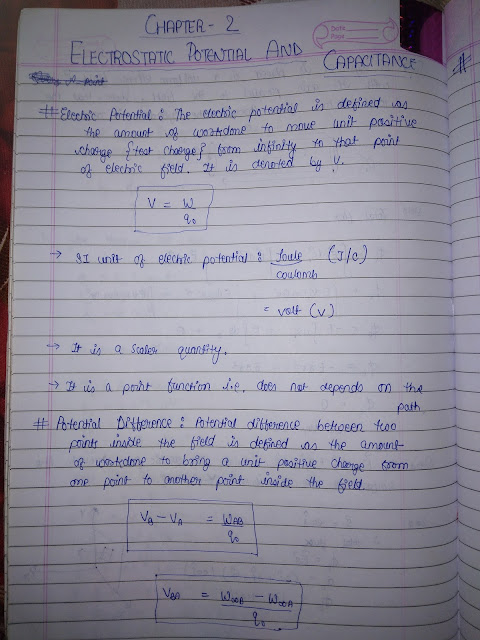D and F block elements | Class 12 Chemistry | Chapter 08 | Handwritten Notes
Click here for Handwritten Notes
1. The elements lying in the middle of Periodic Table between s-block and p-block elements (i.e between group 2 and 13) are known as d-block or transition elements.
2. There are three transition series each of 10 elements:(i) First transition series: It involves filling of 3d-orbitals. It starts from scandium (Z = 21) and goes upto zinc (Z = 30).
(ii) Second transition series: It involves filling of 4d-orbitals. It starts from yittrium (Z=39) to cadmium (Z = 48).
(iii) Third transition series: It involves filling of 5d-orbitals. The first element of this series is lanthanum (Z = 57). It is followed by 14 elements called lanthanides which involve the filling of 4f-orbitals. The next nine elements from hafnium (Z = 72) to mercury (Z = 80) belong to third transition series.
3. The f-block elements are called inner-transition elements.
4. All the transition elements are metallic in nature, good conductors, of heat and electricity; show a gradual decrease in electropositive character in moving across a period. Due to strong metallic bonds, these metals are hard, possess high densities, high enthalpies of atomisation, high melting and boiling points and form alloys with other metals.
5. The melting point of these first increases to maximum and then gradually decreases towards the end of the series. The strength of metallic bonds is roughly related to number of half-filled d-orbitals.
6. The radii of ions, having the same charge and magnitude, in a given series decreases progressively with increase in atomic number. This is because of poor shielding effect of d-electrons.
7. Ionisation energies of transition elements are higher than those of s-block elements but lower than p-block elements. It generally increases from left to right in the series.
8. Transition metals exhibit a variety of oxidation states.
The variable oxidation states of transition metals are due to involvement of ns and (n – 1 )d- electrons in bonding.
9. Most of the transition metals are sufficiently electropositive. They react with mineral acids liberating H2 gas.
10. Transition elements and many of their compounds are paramagnetic,
11. Formation of coloured compounds (both in solid state as well as in aqueous solution) is another very common characteristics of transition metals. This is due to absorption of some radiation from visible light to cause d-d transition of electrons in transition metal atom.
12. In contrast to s-and p-block elements, the transition elements have the ability to form complexes. This is because these elements
(a) have small highly charged ions, and
(b) contain vacant d-orbitals.
13. Many of transition metals and their compounds act as catalyst in variety of reactions.
14. Transition metals form large number of interstitial compounds.
15. A large number of alloys are formed by transition metals. It is due to their atoms mutually substitute their positions easily in their metal crystal lattices.
16. The oxides of transition metals in lower oxidation states are generally basic in nature and those in, higher oxidation states are amphoteric or acidic in nature.
17. The f -block elements have been divided in two series depending upon the fact whether the last electron (differentiating electron) enters 4f- orbitals or 5f-orbitals and accordingly called lanthanides or actinides respectively
18. Actinides show several oxidation states but + 3 oxidation state is most common. The highest oxidation state shown by actinides is + 7.
19. Properties of the lanthanides:
(a) General electronic configuration is [Xe] 4f1-14 5d0-1 6s2.
(b) The metals are silvery-white in colour. They are malleable, ductile, have low tensile strength and are good conductors of heat and electricity.
(c) They have relatively high density and possess high melting points.
(d) The lanthanides exhibit a principle oxidation state of + 3. However, some elements also exhibit + 2 (Eu2+) and + 4 (Ce4+)oxidation states.
(e) Many of the lanthanide ions are coloured due to the electronic transition between different 4 f-levels.
(f) The majority of the lanthanide ions exhibit paramagnetism due to the presence of unpaired electrons. The lanthanoid ions that do not exhibit paramagnetism are those with either no 4f-electrons, e. g., La3+ and Ce4+ or with a completed 4f-level, e.g., Yb2+ and Lu3+.
(g) The lanthanides readily tarnish in air and bum to give trioxides (except cesium, which forms Ce02).
(h) The oxides and hydroxides of the lanthanides are basic in character.
(i) The lanthanoid compounds are generally predominantly ionic.
20. This gradual decrease in atomic size across the first f- transition element series is called lanthanoid contraction.
21. Properties of actinides:
(a) General electronic configuration is [Rn] 5f0-14 6ds0-1 7s2.
(b) The elements are all silvery-white metals.
(c) The melting points of the actinides are moderately high.
(d) The ionic size of the actinides decreases gradually along the series.
(e) The actinides have the ability to exhibit several oxidation states. However, +4 oxidation state is preferred in actinides.
(f) Some actinoid elements can exist in + 6 oxidation state, e.g., uranium, neptunium and plutonium.
(g) Many actinoid elements are radioactive. The elements beyond uranium are man-made.
(h) The actinides have a much greater tendency to form complexes than lanthanides.








Comments
Post a Comment